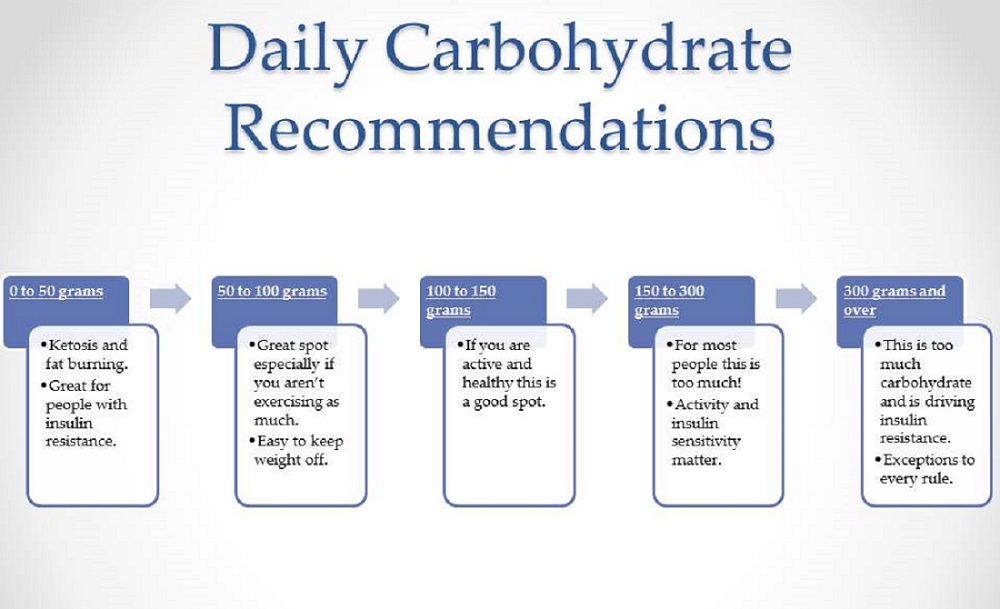
Based on my clinical experience as a functional-medicine doctor, carbohydrate recommendations can be different for each person. If you are a healthy, insulin-sensitive CrossFitter, your body may be better adapt at utilizing glucose for fuel without any negative effects. Some individuals may fall into the category of being insulin resistant or having metabolic syndrome. These individuals have a very difficult time utilizing sugar for fuel and need to utilize a lower carbohydrate plan that allows them to burn ketones/fat for fuel. There are also many people in between on the carbohydrate spectrum! There are exceptions to every rule mentioned.

Your body has no nutritional requirement for carbohydrates. It can actually make its own carbohydrates through a process known as gluconeogenesis, where your liver converts amino acids into glucose. Your body can also convert fat for energy through a process known as ketosis.
There are essential fatty acids and amino acids; these are nutrients our body cannot make and needs to take in through outside food sources. Just because your body has no essential requirement for carbohydrates doesn't mean you should avoid carbohydrates.
When you look at the Food Guide Pyramid, you'll see that over 60% of the recommended macronutrients come from carbohydrate sources. This begs the question, if carbohydrates are not essential, then why are such a large percent of them recommended on the Food Guide Pyramid? Food recommendations are typically made for political reasons, not necessarily scientific reasons. It's a sad state of affairs that the lobbying efforts from massive food corporations tend to dictate what shows up on the Food Pyramid.

When you eat carbohydrates, your pancreas responds by squirting out some insulin so your body can pull the newly broken down glucose into your cells so it can be utilized for energy. If you consume an excessive amount of carbohydrates, or consume carbohydrates that have a higher glycemic load, your pancreas will squirt out an exaggerated amount of insulin to ensure it will be taken up by the cells efficiently. In your body's desire to utilize the glucose, it has actually dropped your blood glucose into a hypoglycemic state.
Most people live their life on these blood sugar swings from high to low. These swings put a tremendous amount of stress on your adrenal and thyroid glands. Hypothyroidism and thyroid imbalances are strongly connected with dysglycemia (swings in your blood sugar).
These ups and downs in blood sugar (dysglycemia) are a hallmark of metabolic syndrome. These swings also create extra sweet cravings—your body is hardwired to crave sweets when your blood glucose drops past a certain point. If you are always triggering your body’s fight-or-flight response with low blood sugar stress, you are telling your genes you are starving and you feel you need food in your mouth as fast as possible. This usually translates to eating some refined sugar and junk food, which sends you back on the same viscous cycle you were just on. Most people live their life this very way!
With habits like this, you will be putting significant stress on your thyroid and adrenal glands as they are required to rev up and down to buffer the hormonal roller coaster!
“Subclinical hypothyroidism is significantly associated with metabolic syndrome.“
Your body can roughly hold about 300 to 350 g of carbohydrates in your muscles. One of the best recommendations for health is to add muscle to your body. Muscle provides structural integrity, enhances performance when moving, and also provides an additional reservoir for carbohydrates. When your carbohydrate levels are tapped off in your muscles, the next place carbohydrates are stored is in your liver. Your liver can only hold about 60 to 80 g more carbohydrates than your muscles, and it can become saturated much quicker.
After the 350 g of carbohydrates your body can hold in your muscles and liver, the remaining carbohydrates are converted to fat. Your body is very efficient at turning carbohydrates into fat and will do so if there are too many carbohydrates coming into your diet.
Click here to help get your blood sugar back in balance now!
When you keep your carbohydrate intake near 50 g per day, you're going to enter a physiological state known as ketosis lipolysis. Most people get scared when they hear the word ketosis, confusing it for ketoacidosis, a state that type I diabetics and alcoholics with liver damage may go into.
Ketosis lipolysis is a normal state of physiology that involves primarily using fat for energy (this happens in fasting too). Fatty acids are broken down into ketones. These ketones are then used for fuel by the body and brain. Ketones also have an appetite-suppressing effect, and after a few weeks in ketosis, you will tend to lose your sweet cravings, too.
This is a spot I typically like to keep my carbohydrate range within; it allows me to not rely on exercise to stay lean and fit. If you have a damaged metabolism, a 0 to 50 g per day range may be where you need to live for a while. Some people also do well cycling in and out of ketosis: three or four days in a row in ketosis and one day in the sweet-spot range or higher.
Carbohydrates are primarily used for instant energy, so if you're doing lots of exercise or you're under higher amounts of stress, getting a little bit of extra carbohydrates from healthy sources may be beneficial.
Most people do well in maintaining their weight when their carbohydrates are within this range. Everyone is different, so depending on how damaged your metabolism is, this range may be too high for you. If you're relatively lean, exercise three to four times a week, and engage in activities like CrossFit, this will be a great place for you to be. I recommend timing a good chunk of your carbohydrate intake post workout as a means to help improve recovery.
When your carbohydrate levels are this high on a continuous basis, especially when there is no energy output to back it up, you are starting to push your body into an insulin-resistant state. The hormone that is secreted when you eat carbohydrates is insulin, and it primarily works by pulling carbohydrates and amino acids into your muscles. Like we talked about above, when your muscles and liver are saturated with carbohydrates, the rest of those carbohydrates will be stored as fat. When your carbohydrate intake is within the 150 to 300 g per day range, it's highly likely it will be stored as fat.
If you're eating based on the Food Guide Pyramid, it's more than likely your carbohydrate intake will be in or around this range. All you have to do is eat your bagel every morning along with your orange juice or cereal, have a sandwich for lunch with your Gatorade, and eat a nice plate of pasta for dinner, and you'll be on your way. Most people that are eating carbohydrates at this high level tend to have insulin resistance as well as increased risk markers for inflammation and metabolic syndrome.
Starchy carbohydrates: White potatoes, sweet potatoes, winter squash, beats, yams, carrots (if cooked), butternut squash, rutabaga, spaghetti squash, turnips, pumpkin, plantains, and bananas. These carbohydrates can have higher levels of sugar along with higher levels of nutrients.
Non-starchy carbohydrates: Broccoli, spinach, kale, celery, brussels sprouts, cauliflower, zucchini, Swiss chard, spinach, asparagus, peppers, onions. These carbohydrates have the lowest level of sugar along with the highest level of nutrients.
High glycemic: Grains, chips, candies, breads, refined sugars, cereals, junk foods, and tropical fruits (bananas, watermelons, pineapples, papaya, mangoes, and all fruit juices). Outside of the whole food fruit sources, higher glycemic carbohydrates tend to have the lowest amount of nutrients with the highest amount of sugar.
Low glycemic: Blackberries, blueberries, strawberries, huckleberries, apples, oranges. these carbohydrates, as a fruit, tend to have the lowest amount of sugar with a higher amount of nutrition.
The carbohydrates that you eat on a daily basis should be of the non-starchy variety, which are all the vegetables your mom tried to get you to eat when you were little.
There are some benefits to the intake of some of the starchy carbohydrates, but you have to make sure they are dosed according to your metabolic constitution and activity level.
When we're looking at the glycemic index, this refers to how fast the sugar in the carbohydrates breaks down and absorbs into your bloodstream. Carbohydrates that have a higher glycemic index get absorbed and impact your blood sugar faster.
The faster the carbohydrates impact your blood sugar, the faster your insulin spikes. When you have pronounced insulin spikes, this drives down your blood sugar, creating sweet cravings just a few hours later. This is a vicious cycle that I see most people live in their entire life. Break the blood-sugar roller coaster by eating healthy proteins, fats, and the right carbohydrates for your metabolic type with each meal.
If you need help getting your blood sugar balanced, click here for more information!
References: